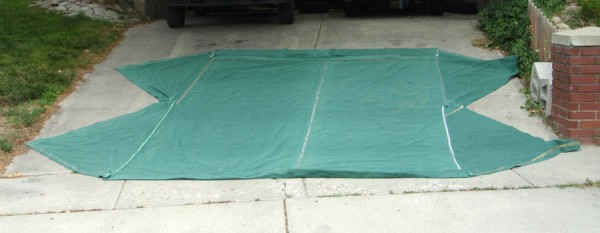 I’ve recently come into the acquaintance of a young fellow who is possessed with a happy obsession with ancient Rome.
I’ve recently come into the acquaintance of a young fellow who is possessed with a happy obsession with ancient Rome.
I know it seems odd, but I actually don’t care much for ancient Rome, even though my ‘nym is associated with it. Rome has a lot of awesome things about it, but in the end it’s too political for me. I just want to ride on my horse, spearing people in battle, not bother with elections and social status signifiers. But I certainly do have an interest in the garb of almost all historical eras.
Zappy, as we will call my young friend, furnished me with the interesting information that the proper size of a toga (which is, of course, constructed of a flat rectangle with curved corners, or sometimes diagonally-cut corners) is twice the height of the wearer by three times the height of the wearer. The true formula is more complicated than that, but I didn’t want to think that hard about it.
This seemed exceptionally huge to me–for a 6-foot man, the toga would be a rectangle 12 by 18 feet. I did the math and found that the smallest yardage you could use of 60″ wide fabric is 16 yards. Sixteen effing yards. This number startled me so that I doubted my ability to mentally do math (especially under the conditions of making garlic bread at work), so I went home and drew it out on a graph paper. It is, indeed, 16 yards of fabric. This is twice the size of a commercial cloak pattern and three times the size of one of my patterns. I cringe when I draft something that uses more than 4 yards of fabric. The size of this toga is comparable to the size of my tent canvas, which I sewed from 15 yards of 60″ wide fabric.

Here's my tent canvas spread out on my parent's driveway. Obviously not the same shape as a toga, but I think you get the point.
But to be realistic, one must consider that linen and wool, the proper historical fabric choices for a toga, both shrink quite a bit when washed. I’ve found, when pre-shrinking fabric, that it generally goes down to 50 inches. So I did more math and found that 18 yards of 50″ wide fabric would be needed to make a toga for a 6-foot man.
Let’s say I make it out of linen, which is far cheaper than wool, though wool is considered by Nova Roma the sole accurate fabric for a toga (I have issues with this which I discuss later). I can get linen for about $7/yard, which is on the cheaper end of the linen spectrum. For 18 yards, that’s $126. It would possibly take me 2 hours to cut the fabric and sew it all by machine (simple seams, but a huge hem).
Using my formula for determining the finished cost of my items, this toga would cost the customer $279. That’s a frickin lot of money for a fancy historical piece of fabric. And that’s on the cheap end. What if I used wool? What if I had hand-finished the seams and hem? What if it were a toga praetexta and I had to edge the whole thing with wide bias tape which I’d have to make from scratch as well? It would cost so much, that my mind boggles. I don’t want to think too hard about it, for fear of hurting myself.
And it’s not like this was a fancy, rich man piece of garb. All male citizens of Rome wore a toga all the time. I don’t even know how you’d wash something so behemoth.
And here’s the thing about wool. It’s difficult to spin and weave as finely as you can do linen, so wool is always a heavier fabric than linen is. Carrying that much weight on your body? Especially in a Mediterranean climate? Not so great. Also, every time you wash it, unless you’re very, very careful, it will get thicker and smaller through the natural and almost unavoidable felting process. Thicker fabric is harder to fold. So if all togas were made of wool, they must have done something really magical to make these things work out for daily wear. And they had to be washed frequently because almost all togas were cream or white colored.
The other thing about wool: the candidate’s togas were supposed to be pure white (everyone else had natural, unbleached, undyed fabric). Linen can be bleached very easily with period methods like washing hot with lye, and prolonged exposure to sunlight. I’m not convinced that wool can be made to a bright white color–white enough to be distinguished from cream at a distance–with period methods. If anyone knows how this can be done, I’d like to hear it. But I’m just not seeing the claim that all togas were made of wool to be practical.
If you don’t care so much about historical accuracy, the 108″ wide muslin and quilting cotton are a good choice. They are very lightweight and you’d only need 8 yards. They probably cost a lot less, too.
I was considering doing a line of Roman garb for my Etsy store, but after doing that math, I’m convinced that no one would actually buy one.
Here’s the moral of the story: In re-enacting, it always comes down to a choice between money and accuracy.





